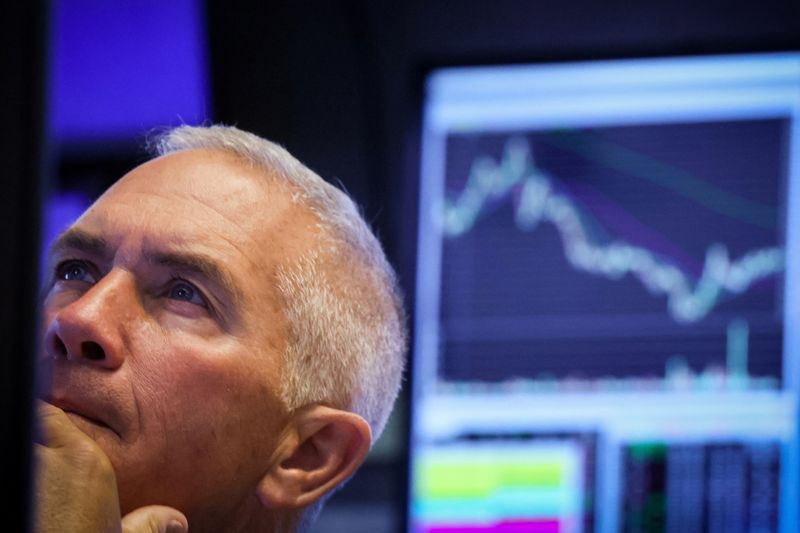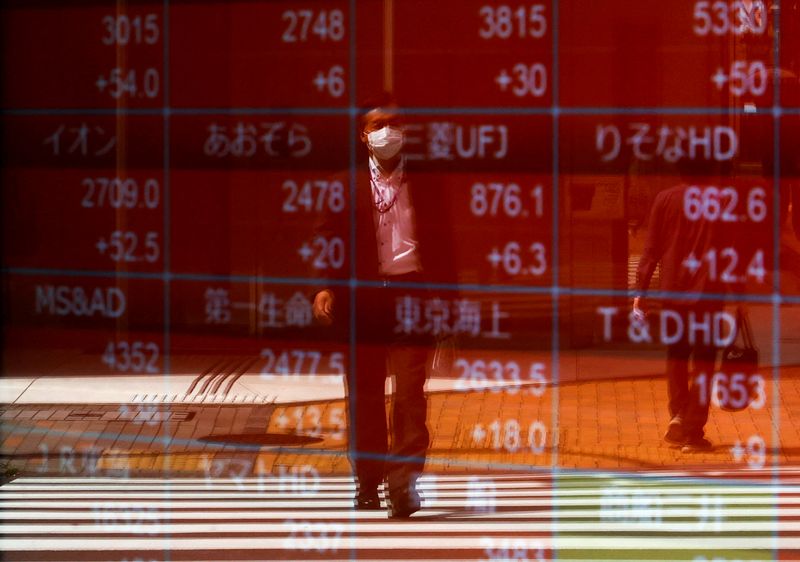US jury says Apple must pay Masimo $634 million in smartwatch patent case
By Herbert Lash
NEW YORK (Reuters) -The dollar rallied and a gauge of global equities slid on Thursday after data once again highlighted persistent U.S. labor market strength, suggesting the Federal Reserve will keep interest rates higher for longer to curb inflation.
Fewer-than-expected Americans filed new claims for unemployment benefits last week, the Labor Department said, though the decline was likely exaggerated by difficulties adjusting the data for seasonal patterns.
Claims are well below the 280,000 level that economists have said would signal a significant slowdown in job growth given the relative size of the U.S. labor market.
The dollar index rose 0.58% against a basket of trading currencies, while futures expect the Fed's overnight rate to rise to 5.41% in November and remain close to or above 5% until May 2024.
In contrast the equity market, driven by tumbling headline inflation numbers and hopes of a "soft landing," expects the Fed to hike rates for the last time at the end of a two-day policy meeting on July 26.
The jobless claims report, along with solid retail sales on Tuesday, pushed Treasury yields up on the idea that the Fed will keep rates higher for longer, said Ben Jeffery, a strategist on the U.S. rates team at BMO Capital Markets in New York.
"We still have some probability of another move in September or November," Jeffery said. "That's probably by the Fed's design. To keep financial conditions sufficiently tight to continue fighting inflation, they definitely want to make sure that there are no cuts priced in 2023."
The two-year Treasury yield, which typically moves in step with interest rate expectations, rose 7.9 basis points at 4.834%, and the benchmark 10-year's yield shot up 10.6 basis points to 3.848%.
Colin Graham, head of multi-asset strategies at Robeco in London, said once rates peak, the only reason the Fed will cut them is if something bad happens.
"The structural view around inflation has to change. People are assuming that the Fed's done enough," Graham said. "Headline (inflation) is coming down due to food and energy. The core PCE hasn't changed and that's the Fed's preferred measure."
Graham referred to the Consumer Price Index (CPI), which year-over-year dipped below 3% in June, and the Personal Consumption Expenditures (PCE) Price Index. Core PCE is running at an annual rate of 4.6%-4.7% this year, more than double the Fed's 2% target for inflation.
The S&P 500 fell 0.68% and the Nasdaq Composite slid 2.05%, both pulled lower as the megacap "Magnificent Seven" all declined, led by Tesla (NASDAQ:TSLA) Inc and Microsoft Corp (NASDAQ:MSFT).
The Dow rose 0.47% to post its ninth straight session of gains, its longest winning streak since September 2017. MSCI's U.S.-centric gauge of global stocks closed down 0.55% to snap an eight-day winning streak.
In Europe, the pan-regional STOXX 600 index rose 0.42% as a jump in metals prices and a 2.3% leap in wheat after Russia struck Ukraine's ports lifted mining and basic resource stocks more than 2%.
Earlier in Asia, equity and commodities markets had pockets of gains after China's government pledged additional support for its economy. However, its tech stocks slid again on festering property concerns.
China's yuan shot up after authorities tweaked cross-border financing rules and major state-owned banks were seen selling dollars. Turkey's lira was stuck near a record low as its second interest rate hike since President Tayyip Erdogan secured a third decade in power in May lagged expectations.
Besides the Fed, investors are focused on policy meetings of the European Central Bank and Bank of Japan next week.
BOJ Governor Kazuo Ueda said on Tuesday there was still some distance to achieving the central bank's 2% inflation target, dousing speculation of a change to its "yield curve control" policy next week.
Traders and analysts expect the ECB to raise its benchmark rate by 25 basis points next week.
Oil prices edged higher on lower U.S. crude inventories and strong crude imports by China, but a weaker demand outlook kept investors cautious.
U.S. crude rose 28 cents to settle at $75.63 a barrel, while Brent settled up 18 cents at $79.64.

Gold prices slipped from a two-month high as the dollar and bond yields ticked higher.
U.S. gold futures settled 0.5% lower at $1,970.90 an ounce.
Should you be buying MSFT right now?
ProPicks AI evaluates MSFT alongside thousands of other companies every month using 100+ financial metrics.
Using powerful AI to generate exciting stock ideas, it looks beyond popularity to assess fundamentals, momentum, and valuation. The AI has no bias—it simply identifies which stocks offer the best risk-reward based on current data with notable past winners that include Super Micro Computer (+185%) and AppLovin (+157%).
Want to know if MSFT is currently featured in any ProPicks AI strategies, or if there are better opportunities in the same space?
